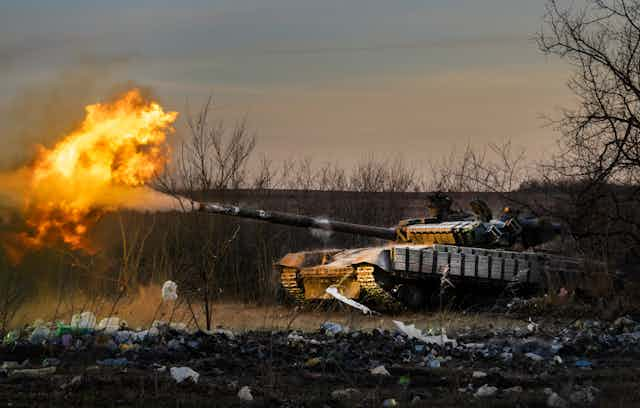The ongoing war in Ukraine is not featuring as prominently in western news media these days as it was earlier in the war, because it has been overshadowed by the unfolding human tragedy of the war in Gaza.
However, the war in Ukraine is still very much ongoing, and both sides are clearly suffering significant losses. Yet it appears that slowly but surely Russia is gaining ground on and off the battlefield.
The recent Ukrainian withdrawal from the stronghold of Avdiivka did make the headlines. On that sector of the front near the city of Donetsk, Russian forces have pushed beyond Avdiivka and continue to gain ground.
Russian forces have also made limited gains on other sectors of the front line.
Meanwhile, the Russian economy is increasingly mobilized for war, and the government has been able to obtain some military resources from abroad, circumventing western sanctions.
All of this means that Russia is, relative to Ukraine, in an increasingly strong position as the war enters its third year.
Russian advantage
While Russian advances are clearly costing their forces heavy losses, the Ukrainian side too is taking significant losses, often when defending increasingly untenable defensive positions. Russian forces typically have a numerical advantage in terms of numbers of troops, artillery and their munitions. In terms of drones — where Ukrainian forces once had an advantage — Russian forces seem to have caught up or even outpaced Ukraine.
Some western commentators have portrayed Russian tactics as mindless attacks with hordes of infantry — sometimes derogatorily described as orcs. The reality is that the Russian army has adapted to the nature of the war today. It is now much better at co-ordinating the activities of artillery, drones and small groups of infantry. Even Ukrainian sources highlight how at least some Russian troops are well-trained and capable.

Western support for Ukraine
There is strong evidence of western intelligence personnel already on the ground in Ukraine — who were there long before February 2022. On top of NATO’s more overt military assistance, such revelations feed into the Russian narrative that the war in the Ukraine is a proxy war between NATO and Russia.
A growing challenge for Ukraine is decreasing western public support for military assistance. In a Gallup poll from November 2023, 41 per cent of U.S. respondents said that the United States is doing too much to support Ukraine — an opinion that rose to 62 per cent among Republican voters. Back in August 2022, these figures were 24 and 43 per cent respectively. This trend is evident in different polls too, as a recent Pew poll highlights.
Read more: Ukraine war: what the US public thinks about giving military and other aid
While there is still strong support within the European Union for providing humanitarian aid to Ukraine, surveys find that support for military assistance is decreasing.
The Ukrainian government has stated its army’s problems can be solved with more western equipment and munitions. Certainly, more of both would improve the Ukrainian position. However, western equipment is not a universal panacea for Ukraine’s problems. Recent reports suggesting Russian forces have destroyed a number of U.S.-supplied Abrams tanks on the Avdiivka sector of the front highlight, unsurprisingly, that western equipment is far from infallible.
NATO countries continue to commit additional military assistance to Ukraine, although additional U.S. assistance is being held up in Congress. The recent scandal in Germany regarding the possible supply of Taurus missiles to Ukraine highlights that a further escalation of western commitments to Ukraine is not a given.
Whether western countries are willing to commit their own personnel to increasingly active roles in the war is unclear. French President Emmanuel Macron recently stated that sending French combat troops to Ukraine remains an option. However, most other NATO leaders seem resolute that sending combat troops to Ukraine should not happen.
Yet, Macron’s position is apparently not without some support. Such a step would undoubtedly increase the possibility not only of a direct NATO-Russia war, but also the use of nuclear weapons.

Manpower issues
Availability of personnel is also a significant problem for Ukraine. Western-supplied equipment still has to be crewed. President Volodymyr Zelenskyy recently stated that 31,000 Ukrainian troops have been killed since February 2022, however, this at best only tells part of the story. This figure is less than half U.S. estimates of Ukrainian troops killed, likely does not include those missing in action, and certainly not those taken prisoner by Russia, nor the tens of thousands of wounded. Replacing such losses is proving increasingly difficult.
Zelenskyy recently gave permission for conscripts who have been serving since February 2022 to move into the reserves for at least 12 months without further callup. Such a step will help improve wider morale, but won’t help with the recruitment crisis.
A significant number of Ukrainians seek to avoid the draft by fleeing to neighbouring countries. This is reminiscent of how young Russians fled to avoid being conscripted in late 2022, although many have now returned.
The sinking of Russian ships in the Black Sea has to some extent replaced less positive news for Ukraine from the front line. The loss of warships such as the large patrol ship Sergei Kotov to Ukrainian naval drone are setbacks for Russia. However, the war for the Donbas is primarily being fought on land, and such Ukrainian victories are unlikely to have a meaningful impact on the ground war.
As the Russian army advances, albeit slowly, the available evidence suggests that resolve remains strong on both the Russian and Ukrainian sides. Outwardly, the majority of NATO leaders retain their commitments to support Ukraine. Both sides are clearly still only willing to consider negotiations on their own terms. How much longer that will continue to be the case remains to be seen.

